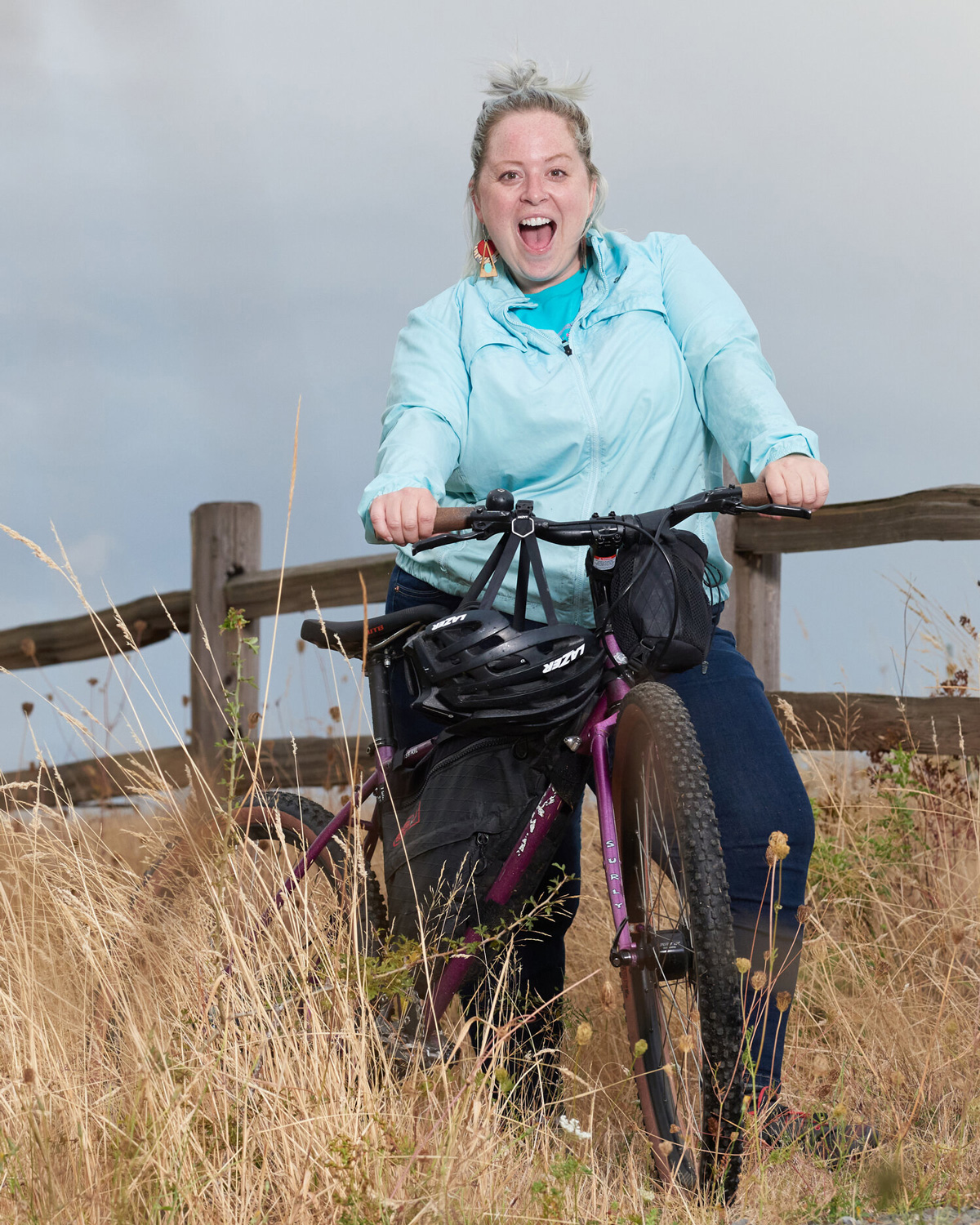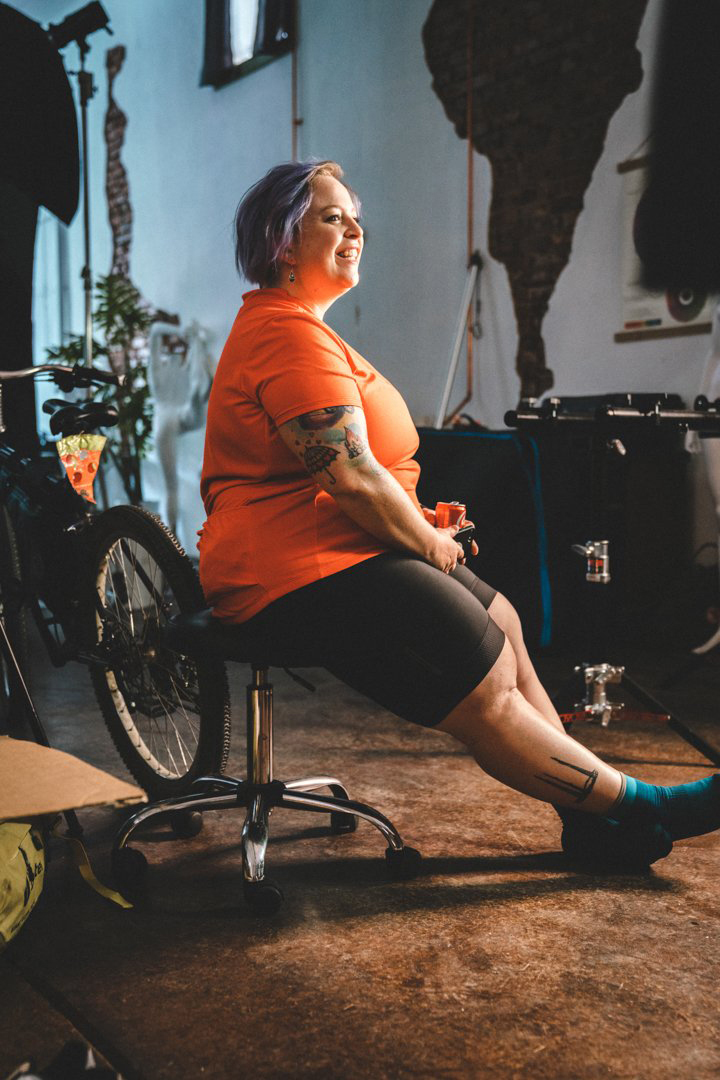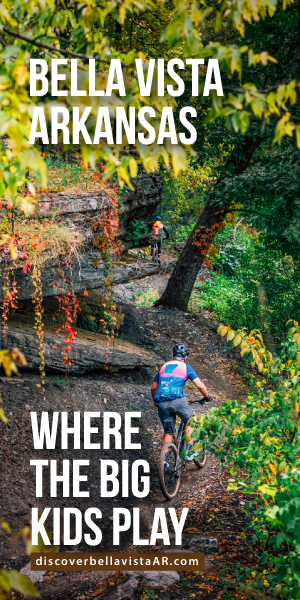A Bike For
Every Body
Marley Blonsky leads a movement for inclusion.
By Lindsay Southwick

GROWING: All Bodies on Bikes has opened 10 chapters across the country. - Photography by Pearl Izumi
When Marley Blonksy dusted off her bike 10 years ago and started blogging about her experiences, she didn’t know there was a whole audience eager to listen. She didn’t know that that audience would turn into a movement. As she clicked away at her computer, she didn’t know that her “little blog” would be the pathway out of her 9-to-5 corporate job. She didn’t know that what she was saying was exactly what the bike industry needed to hear. She didn’t see any of it coming. And the bike industry didn’t see her coming either.
“I never thought of myself as special, or as an expert,” Blonksy said. “I was just telling of my experiences as a person with a bigger body, and people really responded to it. They wanted to know what bike I was riding, what I was wearing. I was saying things that people weren’t used to talking about and it really resonated with them. I started to realize that I did have expertise to share in this space.”
Without intending to, the bike industry has left a considerable segment of the population out of the sport. From bikes to apparel, gear is largely catered toward those deemed “fit.” In other words, small. As society grapples with its long-standing misperception of what a “healthy” body looks like, many brands have changed their tune and their sizing. Bringing awareness to any kind of discrimination is the first step. And it’s not an easy one. Nor is it one that is always welcome. But Blonksy had what it took for the bike industry to buy what she was selling — that all bodies belong on bikes.
Coming to realize she wasn’t alone in her struggle to find gear, clothing or to feel a sense of belonging on her bike was the force behind creating All Bodies on Bikes. The group is not gender specific, nor is it meant to be body positive, as Blonksy is anxious to point out.
“We get lumped into body positivity but that’s not really what we are,” she explains. “We’re body neutral. We just want people to feel like they can do what they want to do, with what they have right now. We’re not doing this for weight loss. To us, we don’t care why you’re riding a bike. We just want to empower you to do it safely and in a way that’s joyful for you.”
As Blonksy began doing advocacy work to bring awareness to this weight discrepancy in cycling, she became more immersed in the bike community. She found herself privy to great conversations being had about equity, inclusion and diversity — all wonderful things. But no one was talking about size inclusion. No one knew how to talk about bigger bodies in a way that was respectful and inclusive. She started doing workshops about it and found herself in rooms where people from the bike industry were. They heard what she was saying and were intrigued by her message.

UNEXPECTED EXPERT: Marley Blonsky never thought sharing her experiences would lead a movement. – Photography by Fontaine Rittleman
“I never thought of myself as special, or as an expert. I was just telling of my experiences as a person with a bigger body, and people really responded to it.”
“The industry has needed a little help in this area,” says Meredith Miller, road sports marketing specialist for Shimano, where Blonksy works as an ambassador. “The industry has taken steps recently to be more inclusive and Blonksy has helped ensure that people with larger bodies are part of that.”
Getting the bike industry behind them really legitimized what All Bodies on Bikes was doing. It was the impetus for Blonksy leaving her corporate job in Seattle, moving to Arkansas, and working with All Bodies on Bikes full time.
“It’s really exciting,” Blonksy said. “Through publicity we’ve managed to garner there is a recognition in the bike industry that there is a whole segment of people that they aren’t reaching, and they want to.”
There are some obstacles that are universal for all cyclists — confidence being at the top of that list. In this way, cyclists with bigger bodies are no different. There are many reasons people can walk into cycling and feel insecure. Maybe you don’t have a $10,000 bike. Maybe you’re slow, or you lack technical skill. Lack of confidence is a major impediment, regardless of the reason behind it.
“Confidence is definitely one of the biggest hurdles we see,” Blonksy said. “People I talk to think they’re too big or out of shape to ride. Or, they think that other people will think they’re too big or out of shape to ride. Neither of those perceptions are OK.”
In addition to the common barriers many cyclists have to overcome, people with bigger bodies also face challenges that are unique to them. For instance, the weight limits of bikes. Bike weight limits can differ depending on discipline, but some tap out at as little as 200 pounds. People with bigger bodies can have a difficult time finding a bike that is appropriate for them. Or, they find themselves on a bike that isn’t right for them that poses a safety risk. On top of that, finding the right apparel is also challenging. This very thing is what led Blonksy to co-founder Kailey Kornhauser, who posted on social media about her experience riding across Alaska without a rain jacket because she couldn’t find one that fit correctly. Any cyclist knows that riding without the right gear can be an issue of safety, not to mention very uncomfortable.

CONFIDENCE FOR ALL: Blonksy advocates that everyone should feel comfortable cycling. - Photography by Pearl Izumi
“I think what Blonksy is doing is amazing. Her voice allows for groups — not just All Bodies on Bikes — but all groups to be included in this sport.”
It seems representation is the word of the moment. We’ve all come to realize we carry biases intentionally or not. Often, once you realize the inequity in one space, it opens your eyes to inequities happening in other spaces as well. You start seeing things you hadn’t noticed before. The bike industry hasn’t been exempt from these realizations. Cycling continues to diversify itself and look for representation in groups outside what has been the presumed “norm.”
Blonksy exudes positivity. She’s the kind of person you just want to be around. It’s easy to see how having open, honest, nonjudgmental conversations are happening with her. It may be safe to assume that her positivity combined with her approaching potentially sensitive conversations with empathy instead of shame have been key to the success of All Bodies on Bikes.
“It’s nobody’s fault,” Blonksy said. “We realize if you don’t live in a bigger body, if it’s not your lived experience, then the challenges of having a bigger body may not have occurred to you. I think approaching it gently has helped make change a little easier. In a lot of ways, the challenges of weight and body size are universal. Everyone knows someone who has a bigger body. And we’ve all felt left out in one way or another. Even if you don’t have a bigger body, everyone knows what it feels like to feel isolated or out of place.”
“I think what Blonksy is doing is amazing,” Miller said. “Her voice allows for groups — not just All Bodies on Bikes — but all groups to be included in this sport. The way she’s spreading her message makes you stop and think.”
And that message has the potential to reach beyond the cycling world. The whole outdoor sports community could benefit from listening to what All Bodies on Bikes is saying.
In the last six months All Bodies on Bikes has had about 3,000 people on its rides. In the year since moving to Bentonville it has opened 10 chapters across the country, with many more interested in doing so. It hosts online classes, regular rides, weekend events and even has a podcast where the focus is on nontraditional athletes. It is all about telling the stories no one else is talking about. It looks for the exceptional in the less-obvious places.
“As a lover of this sport I’m excited to see it being expanded to more people,” Miller said. “What Marley has done shows it’s possible for doors to be opened to anyone. They just need someone to open it.”
The hope for All Bodies on Bikes is that it keeps pedaling forward. It wants to continue growing across the country and having an impact on people. It wants to normalize the conversation about bigger bodies and make bike communities inclusive at every level, in every way.
“I believe in celebrating every ride bike. Every body,” Blonksy said. “Nothing inherently makes someone better than anybody else. I want bike communities to be inclusive beyond just body shape and size. Just generally inclusive. That’s the goal.”


